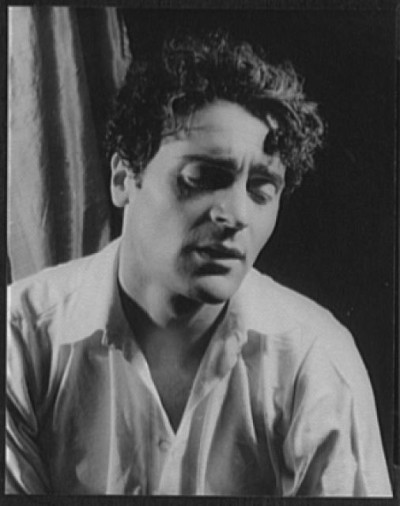Francis Lederer (Francis Lederer)

Lederer fell in love with acting when he was young, and was trained at the Academy of Music and Academy of Dramatic Art in Prague. After service in the Austrian-Hungarian Imperial Army in World War I, he made his stage debut as an apprentice with the New German Theater, a walk-on in the play Burning Heart. He toured Moravia and central Europe, making a name for himself as a matinee idol in theaters in Czechoslovakia, Hungary, Austria and Germany. Notable among his performances was a turn as Romeo in Max Reinhardt’s staging of Romeo and Juliet. In the late 1920s, Lederer was lured into films by the German actress Henny Porten and her producer husband. Because of his good looks, it took some time for the critics to take him seriously, but his association with directors such as G. W. Pabst, for whom he did Pandora’s Box with Louise Brooks, and Atlantic (both 1929), helped him overcome that problem. He was also notable in The Wonderful Lies of Nina Petrovna in the same year. Lederer, who was billed as “Franz” at this time, easily made the transition from silent films to talkies, and was on his way to becoming one of Europe’s top male film stars.
In 1931, Lederer was in London to perform on stage in Volpone and the next year in Autumn Crocus by Dodie Smith, which he then performed on Broadway – using the name “Francis” – where it played for 210 performances in 1932 and 1933. He also performed the play in Los Angeles. His performances attracted attention and film offers from Hollywood. With the deteriorating political situation in Europe, Lederer decided to stay in the United States. He became a U.S. citizen in 1939. Lederer’s first American movies were fairly light fare in which he played the leading man, in films such as Man of Two Worlds (1934), Romance in Manhattan (1934), opposite Ginger Rogers, The Gay Deception (1935), opposite Frances Dee, and One Rainy Afternoon (1936). He won the lead opposite Katharine Hepburn in the 1935 film Break of Hearts, but the producers replaced him with Charles Boyer. It was Irving Thalberg’s plan to make Lederer “the biggest star in Hollywood” but the death of Thalberg ended that, and Lederer never really caught on as a star in the American mode. Although he continued to occasionally play leads – notably when he was a playboy in Mitchell Leisen’s Midnight with Claudette Colbert and John Barrymore in 1939 – in the late 1930s Lederer began to expand his film acting repertoire with offbeat character parts, even playing villains. Edward G. Robinson praised Lederer’s performance as a German American Bundist opposite him in Confessions of a Nazi Spy in 1939, and he earned plaudits for his portrayal of a Fascist in The Man I Married (1940) opposite Joan Bennett. He also played a vampire for The Return of Dracula in 1958.
Throughout his career, Lederer, who studied with Elia Kazan at the Actors Studio in New York, continued to take stage acting seriously, and he performed often both in New York and elsewhere. He appeared in productions of Golden Boy (1937), Seventh Heaven (play) (1939), No Time for Comedy (1939), in which he replaced Laurence Olivier, The Play’s the Thing (1942), A Doll’s House (1944), Arms and the Man (1950), The Sleeping Prince (1956) and The Diary of Anne Frank (1958). Although he took a break from making films in 1941, in order to concentrate on his stage work, he returned to the silver screen in 1944, appearing in Voice in the Wind and The Bridge of San Luis Rey, and in films such as Jean Renoir’s The Diary of a Chambermaid (1946) and Million Dollar Weekend (1948). He took another break from Hollywood in 1950, after making Surrender (1950), and returned once more in 1956 with Lisbon and the light comedy The Ambassador’s Daughter. His final film appearance was in Terror Is a Man in 1959. During the 1950s, he served as honorary mayor of Canoga Park. He would continue to make television appearances for the next ten years in such shows as Sally, The Untouchables, Ben Casey, Blue Light, Mission: Impossible and That Girl. His final television appearance occurred in a 1971 episode of Rod Serling’s Night Gallery called “The Devil Is Not Mocked”. In it he reprised his role as Dracula from The Return of Dracula.
In his later life, Lederer, who had become very wealthy, invested in real estate, especially in the Canoga Park community (renamed West Hills in 1987). He was active in local and Los Angeles civic affairs, philanthropy and politics. He served as Recreation and Parks Commissioner for the city of Los Angeles, received awards for his efforts to beautify the city and was the honorary mayor of Canoga Park for quite a time. He became involved with peace movements, taught acting, and was one of the founders of the American National Academy of Performing Arts in Los Angeles, and the International Academy of Performing Arts in Washington, D.C. In 2000, he was honored by the Austrian government with the Cross of Honor for Science and Arts, First Class. Francis Lederer worked up until the week before he died, at the age of 100, in Palm Springs, California, one of the last surviving World War I veterans of the Austro-Hungarian Army. He was buried at the Forest Lawn Cemetery in Cathedral City, California.
Born
- November, 06, 1899
- Austria-Hungary
- Prague, Bohemia
Died
- May, 25, 2000
- USA
- Palm Springs, California
Cemetery
- Forest Lawn Cemetery
- Cathedral City, California
- USA



